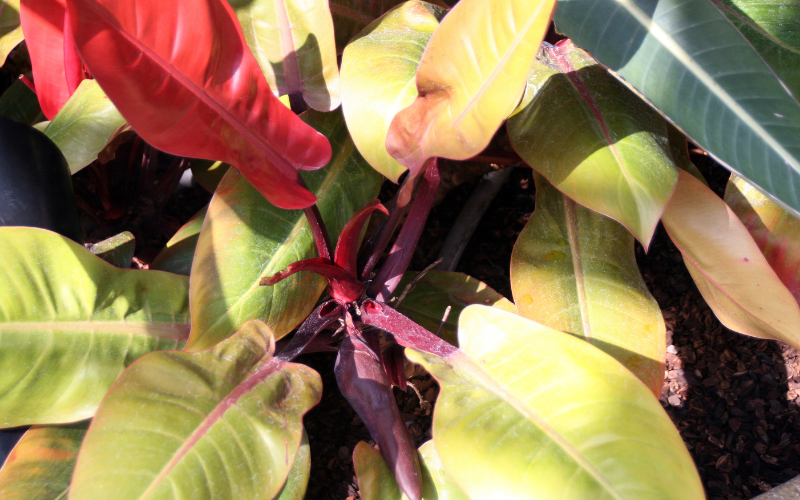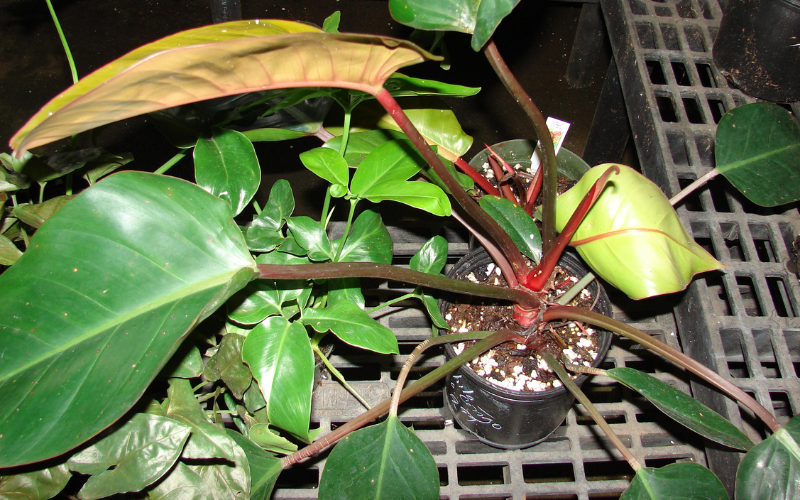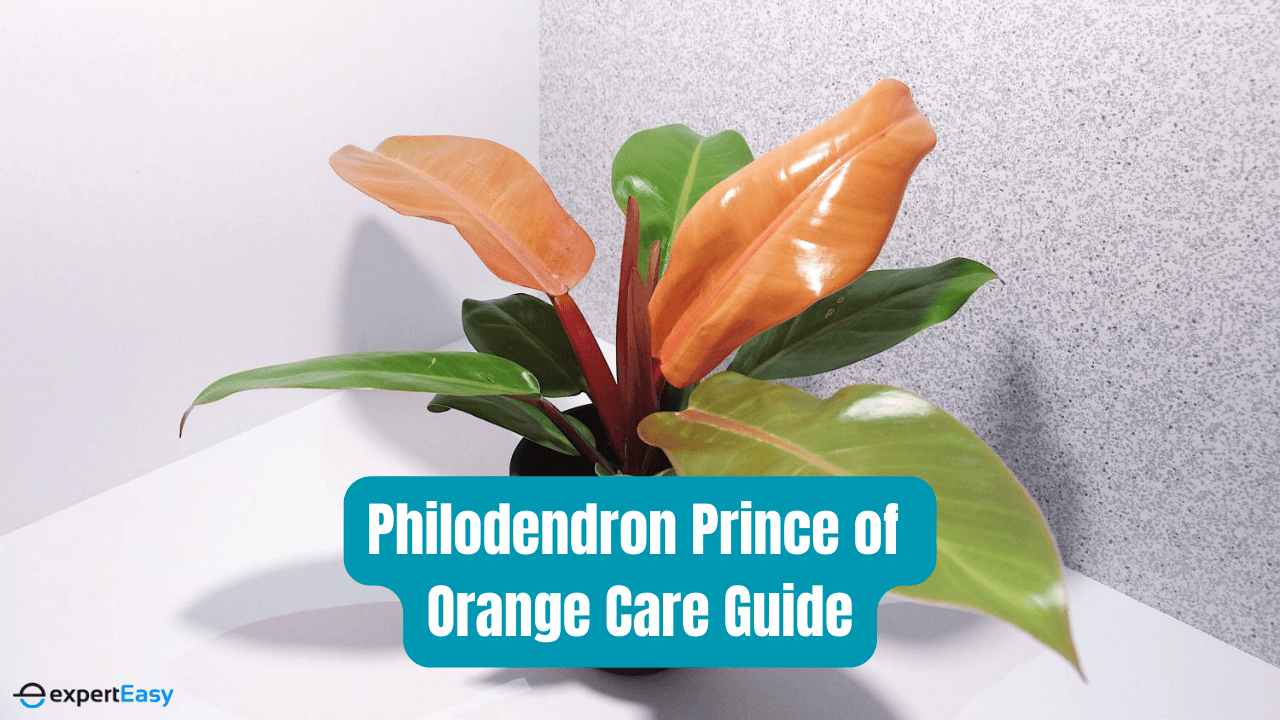If you are looking for a tropical plant to add a splash of colour to your home or office, consider the Philodendron Prince of Orange. The plant is named after its stunning orange foliage that changes colour as it matures, from bright orange to yellow to green. It enhances your surroundings and helps cleanse the air by eliminating toxins. Plus, despite its tropical origins, it's a breeze to care for and thrives with little attention.
Philodendron Prince of Orange: A Quick Overview

The Philodendron Prince of Orange is a self-heading hybrid plant from the Araceae family. It was created by crossing two different species of philodendrons: Philodendron hederaceum and Philodendron erubescens. Both are native to South America, where they grow as ground-level plants in the rainforest, shaded by the canopy above. The plant was patented in 1989.
Philodendron also translates to ‘lover of trees’ in Latin, while erubescens refers to the “blushing” reddish stems seen in some varieties. You can use this plant as an indoor houseplant to add colour and tropical flair to your space. And as established, it can also purify the air by removing toxins such as formaldehyde and benzene. Still, it's important to note that the plant is toxic if ingested, posing a potential hazard to both humans and pets.
Botanical name: Philodendron erubescens 'Prince of Orange’
Common name: Philodendron Prince of Orange, Orange Prince
Family: Araceae
Native: South America
Bloom time: Spring
Hardiness zone: 10 to 12
Soil type: Rich, loamy, and well-draining
Soil pH: 6.0 to 7.0 (mildly acidic to neutral)
Watering: Water if the top inch of soil is dry
Lighting: Bright indirect sunlight
Temperature: 65 to 80ºF (18 to 27ºC)
Humidity: 50% or higher
Fertilising: Once a month in spring and summer
Repotting: Every 1 to 2 years
Propagation: Stem cuttings or divisions
Toxicity: Toxic to pets and humans
Growth rate: Moderate
Mature plant height: 61 cm (indoor) and 91 cm (outdoor)
Growth habitat: Non-climbing
Colour of flowers: White
Shape of leaves: Triangular
Edges of leaves: Serrated edges
Identity colour of leaves: Dark Orange or Orange-hued with brown spots
How to Care for a Philodendron Prince of Orange Plant
While the Philodendron Prince of Orange plant is easy to care for and can thrive in different light and humidity levels, it still needs some attention and care to keep it healthy and happy. Here is what to consider while growing a Philodendron Prince of Orange plant.
1. Light
The Philodendron Prince of Orange is a tropical plant that likes bright indirect light but can also adapt to lower light levels. However, you should avoid placing it in direct sunlight, as this can scorch the leaves and fade their vibrant orange hue. Balance is key when it comes to light exposure – too much light can harm the leaves, while insufficient light can lead to weak growth.
Pick a place in any room of your house where it can get indirect light from the sun. Then, regularly rotate the plant to make sure all leaves are getting equal exposure to sunlight and grow evenly on all sides. If natural light is limited, consider using grow lights as an alternative source.
Best Indoor Grow Lights
If you're looking to propagate the Philodendron Prince of Orange Plant indoors, here are two excellent grow light options that work well with the plant.
a. Spider Farmer SF-1000 LED Grow Light
The Spider Farmer Grow Light has a high-quality Samsung LED chip that provides a full spectrum of light, including white, red, and infrared. It features a dimmable knob that allows easy adjustment of brightness from 0% to 100%, offering a balance between energy efficiency and durability. The grow light also comes with a hanging kit and a user manual, making it easy to install and use.
b. ViparSpectra P600 LED Grow Light
The ViparSpectra Grow Light offers a full light spectrum courtesy of its high-performance SMD LED chip. The colours include white, blue, red, and infrared. A unique feature is its silent cooling fan and an aluminium heat sink that ensures quiet and cool operation. It also comes with a dimmable switch to adjust brightness from 5% to 100%, a hanging kit, and a user manual for effortless setup.
2. Temperature
The ideal temperature range for this plant is between 18°C (65°F) and 27°C (80°F). With heating systems prevalent in most Australian homes, it's easy to find an indoor spot for your plant during winter. In summer, you can move it outdoors, but ensure it is kept out of direct sunlight. Be cautious of cold drafts and heaters, as these can distress the plant and induce leaf damage.
3. Humidity
Philodendron plants thrive in humidity levels of 50-75% year-round. To achieve this, mist your Philodendron Prince of Orange plant once or twice a week or more often if the air is dry. Misting helps increase the surrounding humidity, which the plant favours due to its tropical origins. You can also use a humidifier or a pebble tray or group your plants together to raise the humidity level. Avoid misting in direct sunlight or when the temperature is too cold or hot, as this can damage the leaves.
4. Soil
The Philodendron Prince of Orange prefers a well-draining potting mix that contains peat moss, perlite, and bark. These ingredients help to retain moisture and provide aeration to the roots. You should avoid using soil that is too heavy or soggy, as this can lead to root rot and fungal infections.
For the best potting mix for Philodendron Prince of Orange, consider Planthood's Monstera Potting Mix. It is a premium blend of perlite, orchid bark, and fabulous fertilisers. It is moist, airy, well-draining, and slightly acidic. It comes in a resealable bag that keeps it fresh and moist. This ready-to-use mix is ideal for Philodendron’s growth and health. It will help your Philodendron thrive and produce vibrant foliage.
5. Pot
Choose a pot that is slightly larger than the root ball of the plant. This allows the plant to grow and spread its roots without becoming root-bound or waterlogged. Avoid pots that are too small or too large, as these could stunt growth or cause waterlogging. There are two types of plantar containers that can be used to grow plants indoors or outdoors: Standard planters and Self-watering planters.
Standard planters: Standard planters are simple pots that have drainage holes at the bottom and require regular watering by the gardener. An example is the QCQHDU plant pot.
They are also:
- Cheaper and widely available
- More flexible and controllable over the watering schedule and water quantity
- Better at draining excess water, preventing root rot and fungal infection
- But also more demanding and time-consuming
- More prone to water wastage and mess if not placed on a saucer or tray
- More likely to dry out fast in hot or windy conditions
Self-watering planters: Self-watering planters are more advanced pots that have a water reservoir and a wick system that allow the plants to absorb water as they need it. An example is the Lechuza plant pot.
They are also:
- More costly and rare
- Convenient and low-maintenance
- Consistent and optimal in moisture
- Water-saving and waterlogging-proof by using a closed system that recycles the water
- More challenging to clean and refill if they have a small opening or a complex design
- More susceptible to nutrient loss and salt build-up, requiring occasional flushing with fresh water
6. Watering
It's crucial to strike a balance when watering your Philodendron Prince of Orange. The plant needs regular watering but not overwatering. Before watering, check the soil moisture; if the top 2-3 cm of soil feels dry, it's time to water. Water thoroughly until water drains out of the bottom of the pot, and then empty the saucer to prevent waterlogging.
Never allow the soil to dry out completely or remain overly wet, as both extremes can damage the plant. Signs of overwatering or under-watering include yellowing leaves, wilting stems, brown leaf tips, or drooping leaves. If you observe any of these, adjust your watering routine. Additionally, ensure any excess water in the saucer is drained after watering to prevent root rot and fungal infections.
7. Fertilising
The Philodendron Prince of Orange does not need frequent fertilising but can benefit from a balanced liquid fertiliser during the growing season (spring and summer). Consider fertilising once a month at half-strength, following the instructions on the label. Avoid fertilising in winter when the plant is dormant, as this can cause salt build-up and leaf burn. You must also flush the soil with water every few months to remove any excess fertiliser.
For the best synthetic fertiliser for Philodendron Prince of Orange, consider the All Purpose Liquid Fertiliser NPK 20-20-20 with micronutrients. It's a water-soluble fertiliser that provides balanced nutrition for a wide range of plants. It contains 20% nitrogen, 20% phosphorus, and 20% potassium, as well as iron, manganese, zinc, copper, boron, and molybdenum. The fertiliser can be applied through foliar spray or soil drench, depending on the plant’s needs and preferences.
But if you prefer organic alternatives to synthetic fertilisers, consider the following:
- Compost: Good compost can kickstart microbial growth and aerate poor soil, reducing dependence on chemical inputs.
- Biosolids: A by-product of sewage treatment plants, biosolids have been utilised by a limited number of farms for over two decades. They can increase yields without the use of chemical fertilisers but don’t increase soil carbon.
- BioAgPhos: An eco-friendly alternative to traditional fertilisers, BioAgPhos is a blend of reactive rock phosphate and microbial digestate. It offers improved phosphorus availability compared to conventional reactive rock phosphate, making it suitable for diverse soil types and growing conditions.
8. Pruning
The Philodendron Prince of Orange is a low-maintenance plant that does not require much pruning, but you can prune it to maintain its shape and size, remove any dead or damaged leaves, and encourage new growth. Use clean, sharp scissors or pruning shears and cut just above a leaf node (where a leaf attaches to the stem). While you can prune this plant any time of the year, avoid excessive pruning in one go, as it can stress the plant.
9. Propagation
You can propagate this plant from stem cuttings or divisions. For stem cuttings, you can cut a 10-15 cm section of stem with at least one leaf node and place it in water or moist potting mix until roots develop. You can then pot the rooted cutting in a fresh potting mix and care for it as usual, taking the factors above into consideration.
For division, carefully separate a clump of roots with some stems and leaves attached and pot it in fresh potting mix. Then, thoroughly water the newly divided plant and place it in a shaded area until it recovers.
To maximise propagation success, choose healthy, mature stems and maintain a warm, humid environment for your cuttings or divisions. Regularly change the water or mist the soil and steer clear of exposing them to direct sunlight or chilly drafts, as these conditions could harm them.
Varieties and Cultivars of the Philodendron Plant
The Philodendron Prince of Orange is one of the many varieties and cultivars of the philodendron genus, which contains over 400 species of tropical plants. Let’s see how they differ from Philodendron Prince of Orange Plant.
Varieties of Philodendron Prince of Orange
Some famous varieties of Philodendron Plants are:
- Philodendron Autumn: This variety has leaves that change colour from copper to green as they mature. It also has a climbing growth habit and needs support to grow on. It grows up to 90 cm tall and 60 cm wide.
- Philodendron Prince Albert: This variety has dark green leaves with white veins. It also has a self-heading growth habit and can grow up to 90 cm tall and 60 cm wide.
Cultivars of Philodendron Prince of Orange
Some of the other cultivars in this group are:
- Black Cardinal: This cultivar has dark green to almost black leaves that are glossy and oval-shaped. It grows up to 90 cm tall and 46 cm wide.
- Burgundy: This cultivar has large, heart-shaped green leaves with burgundy undersides. It grows up to 30 cm tall and 15 cm wide.
- Pink Princess: This cultivar has variegated leaves that are dark purplish-green with pink splashes and blotches. It grows up to 10 cm tall and 5 cm wide.
- Red Empress: This cultivar has elongated, serrated-shaped leaves that are darker green with bright red veins and margins. It grows up to 8 cm tall and 8 cm wide.
- White Princess: This cultivar has variegated heart-shaped leaves that are green with white streaks and speckles. It grows up to 90 cm tall and 60 cm wide.
Should You Grow the Philodendron Prince of Orange Indoor or Outdoor?

Propagating the Philodendron Prince of Orange plant is a rewarding and simple process that can be done both indoors and outdoors. Both follow a similar process as detailed above. The major difference? You guessed right; where they are planted. Propagating indoors requires a planter, whiles outdoor propagation requires well-prepared soil. We'll help you decide between the two.
Growing the Prince of Orange Indoor
Are you planning on growing the Philodendron Prince of Orange plant indoors? Here are the pros and cons to help your decision:
Pros:
- You can enjoy the vibrant orange colour of the leaves all year round.
- You can control the temperature and humidity levels to suit the plant’s needs.
- You can protect the plant from harsh weather conditions, such as frost, wind, or hail.
- You can prevent pests and diseases from spreading to other plants in your garden.
Cons:
- You need to provide adequate light for the plant, either by placing it near a window or using a grow light.
- You need to monitor the soil moisture and drainage to avoid overwatering or underwatering the plant.
- You need to clean the leaves regularly to remove dust and improve photosynthesis.
- You need to be careful of the plant’s toxicity to humans and pets, especially if you have children or animals in your home.
Growing the Prince of Orange Outdoor
For outdoor propagation, here are the benefits and drawbacks:
Pros:
- You can let the plant grow naturally and freely without pruning or repotting it frequently.
- You can save space and energy by not using pots, soil, or artificial lighting for the plant.
- You can attract beneficial insects and pollinators to your garden with the plant’s flowers.
- You can create a tropical vibe in your outdoor space with the plant’s lush foliage.
Cons:
- You need to find a suitable spot for the plant that provides bright indirect light but not direct sunlight.
- You need to adjust the watering and fertilising schedule according to the weather and season.
- You need to protect the plant from frost, pests, and diseases that may affect it outdoors.
- You need to be aware of the local regulations and restrictions regarding invasive plants in your area.
Common Pests and Diseases
While it's a resilient plant, the Philodendren Prince of Orange is liable to common problems, such as mealybugs, spider mites, scale insects, aphids, root rot, leaf spot, or bacterial blight. These pests and diseases manifest in various symptoms, such as yellowing, wilting, curling, or spotting of the leaves, sticky or cottony substances on the stems and leaves, or black/brown lesions on the plant tissue.
Interventions
You can proactively prevent and treat these problems using organic or chemical methods, depending on the severity and type of the issue. Regularly inspecting the plant for signs of infestation or disease, wiping pests off with a cloth or cotton swab soaked in alcohol, spraying with insecticidal soap or neem oil, removing any diseased leaves or stems, and enhancing air circulation and drainage around the plant are all effective strategies. You can also use fungicides or bactericides if the infection is severe and widespread.
Good Hygiene Practices
You should practice good hygiene and sanitation when dealing with pests and diseases, such as washing your hands and tools before and after handling the plant, isolating any affected plants from others, disposing of any infected plant material properly, etc. Remember to wear gloves when handling the plant due to its calcium oxalate crystals that can irritate the skin. These measures should help prevent the spread of pests and diseases to other plants and ward off reinfection.
Companions and Accessories
The Philodendron Prince of Orange is a stunning plant that can create a beautiful display. But you can pair it with other tropical plants or accessories to enhance its appearance and create a cohesive theme. Some of its best companion plants include:
- Monsteras and other Aroids: These plants have similar care requirements and leaf shapes as the Philodendron Prince of Orange, and they can create a lush and exotic look with their large and glossy leaves.
- Bird of Paradise: This plant has striking orange and blue flowers that contrast well with the green and orange leaves of the Philodendron Prince of Orange. It also adds height and drama to the display.
- Areca Palms: These palms have feathery fronds that add texture and movement to the display. They also provide shade and humidity for the Philodendron Prince of Orange, which prefers indirect light and high moisture levels.
- Crotons: Crotons have colourful and variegated leaves that match the Philodendron Prince of Orange well. They also add variety and interest to the display with their different shapes and patterns.
For accessories, here are the best options for the Philodendron Prince of Orange plant:
- Terracotta pots: These pots have a natural and rustic look that complements the tropical vibe of the Philodendron Prince of Orange. They also allow the soil to breathe and drain well, which prevents overwatering and root rot.
- Wicker baskets: These baskets have a cosy and warm look that contrasts well with the bright and vibrant leaves of the Philodendron Prince of Orange. They also add texture and dimension to the display.
- Macrame hangers: These hangers have a boho and chic look that suits the Philodendron Prince of Orange. They also allow you to hang the plant from the ceiling or wall, which saves space and creates a vertical display.
- Pebble trays: These trays have a simple and elegant look that enhances the beauty of the Philodendron Prince of Orange. They also increase the humidity around the plant by evaporating water from the pebbles, which improves its health and growth.
Where to Buy or Source a Philodendron Plant in Australia?
If you are looking for Philodendron plants online in Australia, you have many options to buy or source them from reputable nurseries. Some of the best places to buy Philodendron plants online in Australia are Nursery 2U, Cheeky Plant Co., and Nurseries Online Australia.
These online retailers offer a wide range of Philodendron species and varieties, such as Philodendron White Princess, Philodendron Birkin, Philodendron Xanadu, Philodendron Gloriosum, and more. They also provide detailed information about the plants they sell, such as care tips, light requirements, water needs, and pot size.
Remember to select a vibrant, healthy specimen that has glossy, verdant leaves and robust stems and shows no visible signs of pests or diseases. It's also prudent to familiarise yourself with the delivery and return policies of your chosen online retailer should you have to return it.
Are you planning a garden redesign or in need of some landscaping advice? Our guide on how to find the best landscaper in Australia is a great resource. These professionals provide everything from design inspiration to full-service landscaping, helping you transform your outdoor space into a beautiful garden masterpiece.
🪴Need Assistance With Gardening?
Whether you're a seasoned green thumb or just starting out in gardening, there's always more to learn. Immerse yourself in our guide to finding the perfect gardener in Australia. These top-rated professionals offer a variety of services, from plant selection to garden maintenance, ensuring your garden remains vibrant and healthy.
🌲Seeking Help With Lawn Care?
Maintaining a beautiful lawn can be a significant undertaking. If you're in need of expert assistance, look no further than our carefully curated guide on choosing the right lawn mowing service in Australia. These experts can help keep your outdoor spaces at their greenest and cleanest best with their lawn mowing and care expertise.
Frequently Asked Questions (FAQs)
Here are some frequently asked questions about the Philodendron Prince of Orange.
Why is my Philodendron Prince of Orange turning yellow?
Your Philodendron Prince of Orange may be turning yellow due to overwatering, under-watering, nutrient deficiency, pest infestation, or low light. Overwatering usually produces a combination of yellow or brown colour on the same leaf, while under-watering turns the leaf to full yellow colour with a few brown crispy spots on other leaves too.
Sometimes, yellowing occurs due to chlorosis which is the deficiency of magnesium and iron. Check the soil moisture, drainage, fertiliser, and light levels and adjust them accordingly. Remove any yellow or damaged leaves and treat any pests with insecticidal soap or neem oil.
Why has my Philodendron Prince of Orange stopped growing?
Your Philodendron Prince of Orange may have stopped growing due to insufficient light, water, or nutrients. Make sure your plant gets bright indirect light, moist but well-drained soil, and a balanced fertiliser once a month during the growing season.
Also, consider maintaining a humidity level of 50-75% in your home for the smooth growth of your philodendron plant. You can also prune your plant to stimulate new growth and repot it if it is root-bound.
How often should I fertilise my Philodendron Prince of Orange?
You should fertilise your Philodendron Prince of Orange once every month during the spring and summer with a balanced liquid fertiliser diluted to half-strength. Avoid fertilising in the winter when the plant is dormant. You can also add some organic matter, such as compost or worm castings, to the soil to enrich it.
How often do I need to repot my Philodendron Prince of Orange plant?
You need to repot a mature Philodendron Prince of Orange plant every 1 to 2 years or when you notice that the roots are crowded or coming out of the drainage holes. Spring is the best season to repot the plant.
When the roots start protruding through the drainage holes, this tell-tale sign indicates that your plant needs repotting. Choose a pot one size larger than the current one and use a fresh potting mix. Repotting will give your plant more space to grow and improve its health.
How to revive my Philodendron Prince of Orange plant?
To revive your Philodendron Prince of Orange plant, you need to identify and fix the problem that is causing it to decline. Some common issues are overwatering, underwatering, low light, pests, or diseases.
Check the soil moisture, drainage, light level, and leaf condition and adjust them accordingly. Water only when the top inch of soil is dry, provide bright indirect light, remove any damaged leaves or stems, and treat any pests or diseases with appropriate methods.
Is the Philodendron Prince of Orange plant toxic to my pet?
Yes, the Philodendron Prince of Orange plant is toxic to pets and humans. It contains calcium oxalate crystals that can cause irritation, swelling, pain, and difficulty swallowing if ingested. Keep your plant out of reach of children and animals, and contact a doctor or veterinarian if you suspect poisoning.
How can I maintain the orange colour of the leaves of my Philodendron Prince of Orange plant?
You can maintain the orange colour of the leaves of your Philodendron Prince of Orange plant by providing it with bright indirect light, as this will encourage new growth that emerges with a deep orange-bronze hue.
You can also prune your plant regularly to remove any older leaves that have turned green and make room for new ones. However, you should know that the orange colour is temporary and will fade to green as the leaves mature.
Is Philodendron Prince of Orange an indoor or outdoor plant?
Philodendron Prince of Orange can be grown both indoors and outdoors, depending on your climate and preference. It is a tropical plant that prefers warm, humid, and shady conditions, so it can thrive outdoors in hardiness zones 10 to 12, where there is no risk of frost or extreme heat.
However, it can also adapt well to indoor environments as long as it gets enough light, water, and humidity. It is a compact and self-heading plant that does not need much space or support.
How do I acclimate my Philodendron Prince of Orange plant to outdoor conditions?
If you want to move your Philodendron Prince of Orange plant from indoors to outdoors, you need to acclimate it gradually to avoid shock and damage. You can start by placing your plant in a shaded spot outdoors for a few hours a day, increasing the duration and exposure for one to two weeks.
You should also monitor the soil moisture and temperature and adjust them accordingly. You should avoid moving your plant outdoors if the temperature is below 10°C (50°F) or above 32°C (90°F).
Wrapping Up
The Philodendron Prince of Orange is a stunning plant that will reward you with its vibrant foliage and growth. And we hope you found this guide useful and learned something new about the Philodendron Prince of Orange. Please share your experience with this plant with your friends and family or with other plant lovers online. If you have any questions or comments, please feel free to leave them below or contact us for more information. We would love to hear from you and help you with your plant journey.







